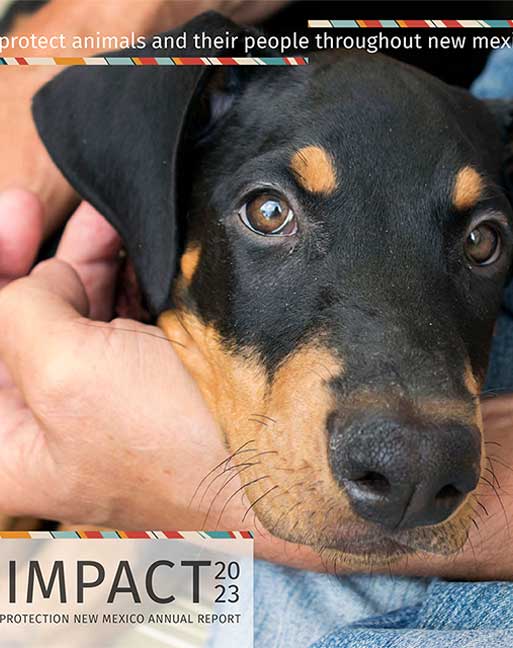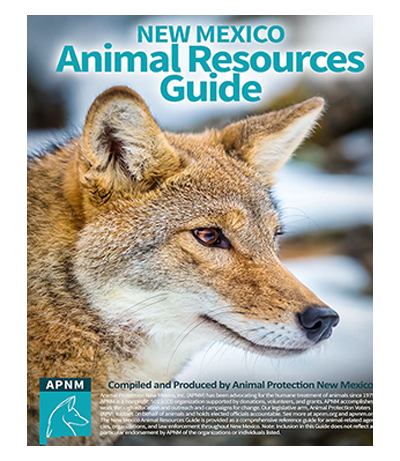Companion Animal Initiatives
- APNM issued training scholarships and travel stipends to 30 law enforcement officers from throughout New Mexico so they could attend one of two nationally-recognized and accredited week-long Cruelty Investigations training workshops held in Rio Rancho in the spring and fall;
- APNM began the process of garnering support from local officials for the successful transition of Clovis’ and Hobbs’ municipal shelters to humane euthanasia methods. Hobbs has agreed to the switch and APNM is still in negotiations with Clovis;
- In conjunction with the New Mexico Department of Motor Vehicles, APNM launched New Mexico’s spay-neuter license plate, which will raise awareness of the cat and dog overpopulation crisis in our state and raise funds for county-level spay-neuter programs. APNM created and is distributing statewide a promotional poster;
- APNM hired a part-time cruelty case administrator for more consistent and effective monitoring of and intervention in cruelty cases not being properly handled by law enforcement. This approach has resulted in dramatically improved services for the public seeking assistance with cases, as well as three prosecutions of fourth degree felony-level cruelty in Capitan and the resignation of a police chief in Melrose, following the community’s investigation of his random shooting of dogs;
- As a result of APNM/APV staff working with the New Mexico Public Education Department, which changed its regulations to mandate giving students the choice of learning from virtual dissections instead of animal specimen dissection, in May students in Santa Fe became the first to learn dissection from APNM’s lending library of computer models;
- APNM continued to provide technical support to communities throughout New Mexico who find no assistance within state government for guidelines on shelter management and animal control standards.
Wildlife Initiatives
- APNM, in cooperation with the N.M. Department of Game and Fish, succeeded in reducing the hunting quota for cougars, and convinced the department to use a state-of-the-art mapping model to estimate cougar populations from which hunting quotas are determined. APNM paid for the mapping when the department could not. APNM also convinced the department to begin gathering reliable data on cougars killed, in order to assess important cougar population trends;
- APNM, along with the Rio Grande chapter of the Sierra Club, the New Mexico Wilderness Alliance and the Center for Biological Diversity, launched a steering committee and began drafting detailed plans for accomplishing the ambitious goal of banning leg-hold traps and poisons on New Mexico’s public lands;
- APNM continued to participate in the Tijeras Canyon Safe Passage Coalition, which successfully worked with the New Mexico Department of Transportation to secure key recommendations for safer highway passages to benefit animals and drivers. APNM coordinated volunteers for brush clearing and other fieldwork;
- APNM, along with New Mexico Game and Fish and Tesuque and Pojoaque Pueblos, conducted an investigation and analysis of safe passage opportunities along US285 north of Santa Fe. The analysis revealed two ways to improve safe passages: using native plants not attractive to wildlife to re-vegetate disturbed areas and creating breaks in the center concrete barrier. APNM will pursue the implementation of these recommendations with the New Mexico Department of Transportation;
- APNM worked with Senator Jeff Bingaman’s office to increase pressure on the National Institutes of Health, which is ignoring illegal, improper and life-threatening practices by Charles River Laboratories–the corporation responsible for the care of chimpanzees at the Alamogordo Primate Facility located on Holloman Air Force Base;
- APNM’s involvement in citizens’ complaints about wild bird deaths at a Rio Rancho golf course resulted in the New Mexico Environment Department investigating and finding the golf course in violation of their waste water permit. As a result, the department has initiated a massive clean-up effort, and has made a commitment to include “impact on wildlife” a part of their permit requirements–something that had previously been non-existent;
- APNM launched its beaver coexistence campaign at the wildly successful Beavers Belong! workshop in Taos in September. Already New Mexico Game and Fish, other state and federal agencies, Native nations and acequia associations are anxious to work with APNM on this project that has enormous potential for river restoration and water conservation efforts. The first of several beaver dam mitigation devices was installed and demonstrated immediate results, and APNM’s volunteer “Beaver Brigade”–which will assist with mitigation projects–is already in motion.




